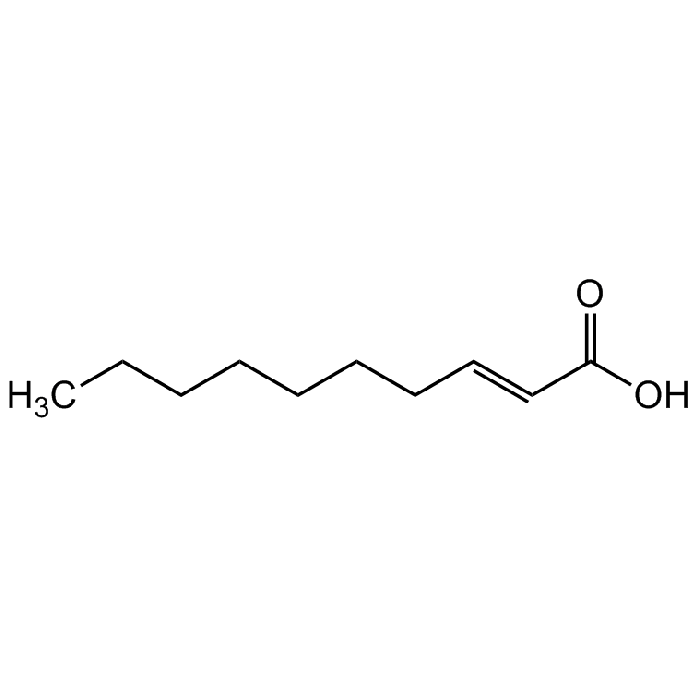Cookie Policy: This site uses cookies to improve your experience. You can find out more about our use of cookies in our Privacy Policy. By continuing to browse this site you agree to our use of cookies.
Chemodex
trans-2-Decenoic acid

| Product Details | |
|---|---|
| Synonyms | (E)-2-Decenoic Acid; trans-2-Decylenic Acid; Streptococcus Diffusible Signal Factor; SDSF |
| Product Type | Chemical |
| Properties | |
| Formula |
C10H18O2 |
| MW | 170.25 |
| CAS | 334-49-6 |
| Source/Host Chemicals | Synthetic. |
| Purity Chemicals | ≥95% (NMR) |
| Appearance | Viscous oil. |
| Solubility | Soluble in DMSO, DMF (both 30mg/ml) or ethanol (20mg/ml). |
| Identity | Determined by 1H-NMR. |
| Declaration | Manufactured by Chemodex. |
| Other Product Data |
Click here for Original Manufacturer Product Datasheet |
| InChi Key | WXBXVVIUZANZAU-CMDGGOBGSA-N |
| Smiles | CCCCCCC/C=C/C(O)=O |
| Shipping and Handling | |
| Shipping | AMBIENT |
| Short Term Storage | +4°C |
| Long Term Storage | -20°C |
| Handling Advice | Protect from light and moisture. |
| Use/Stability | Stable for at least 2 years after receipt when stored at -20°C. |
| Documents | |
| Product Specification Sheet | |
| Datasheet |
 Download PDF Download PDF |
trans-2-Decenoic acid is an unsaturated short chain fatty acid that is secreted by S. mutans. It is a novel interkingdom-signaling molecule (from a Gram-positive organism) that inhibits hyphal formation of the dimorphic fungus C. albicans by blocking the yeast-to-hyphal morphological transition. It might play a critical role in regulating the disintegration of aerobic granules. As in other parts of the body, Streptococci and Candida coexist in the mouth and compete for the same substrate. In a mixed species environment such as the oral cavity the quantitative and qualitative nature of the bacteria modulates the biofilm formation of C. albicans. trans-2-Decenoic acid is structurally similar to undecylenic acid, the active ingredient of Desenex, a widely used antifungal agent. In addition, trans-2-Decenoic acid inhibited the luciferase reporter activity and therefore the bioluminescence of the Gram-negative marine bacteria Vibrio harveyi. trans-2-Decenoic acid is found in royal jelly produced from the hypopharyngeal and mandibular gland secretions of honeybees. Demonstrates weak estrogenic activity, inhibiting binding of 17β-estradiol to estrogen receptor β.
(1) K.M. Suzuki, et al.; Evid. Based Complement. Alternat. Med. 5, 295 (2008) | (2) D.G. Davies & C.N.H. Marques; J. Bateriol. 191, 1393 (2009) | (3) R. Vilchez, et al.; ChemBioChem 11, 1552 (2010) | (4) P.-J. Cai, et al.; Biores. Technol. 182, 823 (2013)





